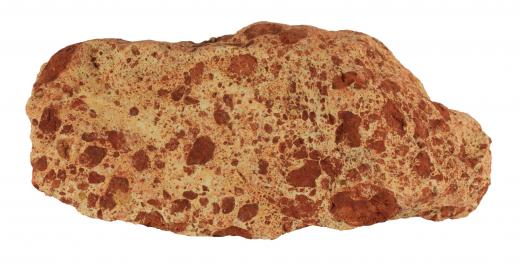What Is the Bayer Process?
The Bayer process is an industrial process by which bauxite is purified into alumina, or aluminum oxide. Named for Karl Bayer, who developed it in the late 19th century, this process is an essential intermediate step in the production of aluminum metal. Alumina is produced through a series of controlled chemical reactions from bauxite, a naturally occurring aluminum ore. Three major steps are involved in the Bayer process: extraction, precipitation, and calcination.
Bauxite contains the aluminum-bearing minerals boehmite, gibbsite, and diaspore. To extract these minerals and the alumina in them, the bauxite must be ground up into small particles and dissolved in sodium hydroxide, a caustic liquid. Steam and pressure are applied during this digestion process. Alumina in the minerals reacts with sodium hydroxide, forming sodium aluminate.

Some components of bauxite, such as iron oxides and silicates, do not dissolve during digestion. These substances create a slurry of red mud, which is filtered off from the alumina-containing liquid through a process called settling. Red mud is washed to recycle the original sodium hydroxide, and is eventually stored in holding ponds. Since it cannot be recycled and is extremely difficult to dispose of and store, red mud is a waste issue for production facilities using the Bayer process.
Precipitation is the next step after extraction. Aluminum hydroxide precipitates out of the alumina mixture as it is cooled. It solidifies into this crystal state by forming alumina crystals around “seeds” of alumina, particles that have been suspended in the processing tanks to promote crystal growth. The coarser alumina crystals are removed for the next step, while the smaller, finer grains are reused as seeds for the precipitation reaction.
The final step in the Bayer process is calcination. The precipitate mixture from the previous step is heated to a temperature of about 1,922°F (1,050°C). This causes the aluminum hydroxide to give off moisture in water vapor and decompose chemically into alumina, the final product. Ideally, the particles of alumina produced will be small and fine, roughly the size of sand grains.
Almost all of the world’s aluminum is produced using alumina generated from the Bayer process. After the alumina has been purified from bauxite, it is smelted into aluminum metal. The uses of aluminum are vast and varied, ranging from consumer packaging to automobile parts, paints, cosmetics, and even pharmaceuticals. The increased recycling of aluminum has helped to alleviate the problem of red mud waste, since new alumina is not produced as often as in the past.
AS FEATURED ON:
AS FEATURED ON:











Discuss this Article
Post your comments